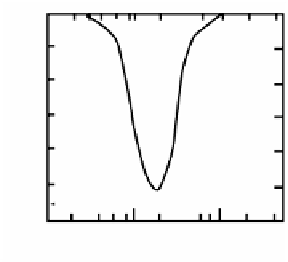Environmental Engineering Reference
In-Depth Information
100
1 cm/sec
90
10 cm/sec
Diffusion +
Interception
80
I
mpaction+
Interception
Diffusion
70
0.01 0.1 1.0
Particle Diameter (
m)
µ
Figure 12.3
Relationship between particle size and collection efficiency. (From
Hinds, W.C.,
Aerosol Technology — Properties, Behavior, and Measurement of Airborne
Particles
, John Wiley & Sons, New York, 1982. With permission.)
Figure 12.4
Relationship between filter fiber diameter and collection efficiency.
(From Hinds, W.C.,
Aerosol Technology — Properties, Behavior, and Measurement of
Airborne Particles
, John Wiley & Sons, New York, 1982. With permission.)
As indicated in Equation 12.1, particle penetration decreases with
increasing filter thickness. Collection efficiency increases as well. However,
as filter thickness increases, resistance to air flow also increases, with a
corresponding pressure drop and decreased air flow through the filter. Pres-
sure drop is directly proportional to filter thickness and inversely related to
fiber diameter. A significant pressure drop is undesirable because it reduces
the air flow rate and volume of air treated.
3.
Filter applications and types
Filters are used in a variety of air cleaning applications. Dust-stop filters
used in HVAC systems and residential heating and cooling units are the
major application. Higher-efficiency in-duct filters may be used to improve
the physical cleanliness of indoor surfaces and reduce airborne allergen
levels in residences. Free-standing modular air cleaners employing fibrous






















